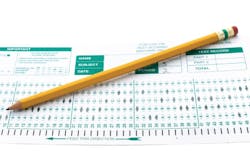Technicians will often claim to know everything they need to know to be successful during job interviews. It’s common for shops to hire job candidates based on false claims—and it shows when new employees actually start working on cars, says shop manager Jeff Turner.
At least that’s what Turner has experienced at his facility, Elite Euro Cars Collision Services Inc. in Spring Hills, Fla. He’s been burned by technicians who create solid impressions during the interview, but demonstrate less than adequate skills the first day on the job.
Turner says he’s worked with several technicians who don’t have the most basic of knowledge needed to fix cars. Many haven’t been able to comprehend estimates or differentiate various car parts and components. Some, he says, haven’t even been able to read or write in English altogether.
“I’m a small shop, so each person who works here really makes a big difference in the success of daily business,” Turner says. “With only four employees, it’s a significant burden when time is wasted on a new hire who can’t perform.”
Turner recently decided to add another step to his hiring process by administering written technical exams to technician candidates during the interview. He’s in the infancy stages of developing a test that will cover things like automobile design, estimating processes, basic repair processes, and various collision-related vehicle components.
“I want to get a feel for potential employees’ educational backgrounds to identify their level of competency,” Turner says.
The entire goal is to proactively verify the training and certifications technicians claim to have, and to improve the quality of the staff by not putting less than desirable employees to work.
John Spoto, MSO key account manager for 3M Automotive Aftermarket, and Sabrina Clark, owner of Sabrina Clark Consulting, have both worked with several shops to help administer written technician exams that can be used before extending official job offers. They both agree it’s a solid strategy to weed out weak performers up front, or to serve as the deciding factor between several great candidates.
Spoto and Clark helped break down what exactly these tests entail, how to analyze the results, and why every shop should add this component to their list of best hiring practices.
Protect Administrative Investments
So many other industries, including attorneys, doctors and hairdressers, require professionals to prove their skills and knowledge in order to get hired, Spoto says. But that practice is extremely uncommon in the automotive repair sector. Shop owners too often hire technicians based on “mouth abilities”—talking a good game—rather than technical abilities.
That backfires on shops constantly, Spoto adds. Owners take chances on technicians, only to find out later that their skill level isn’t where it needs to be. And that leads to turnover and frequent replication of the hiring process.
“Shops can’t continue to afford the human resources costs of high turnover,” Spoto says, noting it can be a several thousand dollar investment for every new hire when you tally up the cost of conducting interviews, background checks, drug screenings, administrative requirements, and training. “Why would you want to make that investment on an individual you’re going to lose anyway?”
Shops can contact their local 3M representatives to obtain sample tests to replicate. But if you opt to create the documents on your own, Clark suggests doing some research first to develop an appropriate list of questions.
She recommends analyzing various certification tests from some of the industry’s most prominent training organizations, such as I-CAR and ASE. Don’t replicate those tests entirely, Clark advises, but select certain questions or concepts that match the job description, skill sets and proficiency you’re looking for in a specific position.
After creating the test, Spoto says the additional hiring process creates no extra work or financial investment for owners, while preventing those costly human resources challenges for the business.
“These tests help alleviate administration costs by improving the hiring practice and keeping more people employed long term,” Spoto says.
The Tests
The written exams shouldn’t be extremely extensive, Spoto says. They should include 12–20 multiple-choice questions and require a maximum of 20 minutes to complete following the normal in-person interview.
Spoto and Clark both suggest developing a separate test for each department of the shop—detail, structural, body, refinish and estimating—based on the core competencies required for each position.
Here’s a rundown of what each test should entail:
Department: Detail
Topics to Cover: how to clean vehicles; blow vents out; perform final washes; detect the affects of acid rain; remove various types of paint scratches
Sample Questions:
1. When removing masking tape from the substrate, at which angle should you pull to ensure clean removal?
2. Regardless of the quality of paint job, should you always sand and buff all painted surfaces?
3. Which of the following is the proper speed to run your buffer?
Department: Structural
Topics to Cover: metal identification; welding procedures; conditioning welds; proper feather-edge welds; grinding welds
Sample Questions:
1. When grinding a plug weld, which of the following products is acceptable to use?
2. To featheredge the front and backside of a plug weld, you should start the sanding process with which grit?
3. After resistance welding, you should condition the weld with which of the following items?
Department: Body
Topics to Cover: prepping metal; penetrating metal; how to begin repairs; adhesive applications; plastic repair; feather edging processes; material usages for various processes
Sample Questions:
1. When removing paint from the substrate prior to stud-pulling the metal, which of the following products would you use?
2. When removing a hem flange from a door skin, which of the following products would you use?
3. When preparing two surfaces for mating (weld panels), what is the proper grit Roloc to use for this application?
Department: Refinish
Topics to Cover: materials for prepping; dry primer sanding; prepping for sand scratches; feather edging; blending panels; de-glossing edge panels; how to avoid paint defects
Sample Questions:
1. What is the proper width masking tape for outlining the critical edge of the area to be refinished?
2. When masking jambs, which products should be used?
3. Prior to refinishing, all parts should be re-cleaned with which of the following materials?
Department: Estimating
Topics to Cover: collision theory; airbag components; suspension components; difference between caster, camber and tow; types of frame damage including sag, sway and mash
Sample Questions:
1. How much time is typically required to set up and measure a vehicle for frame pulls?
2. What type of collision typically causes frame “mash”?
3. Which type of steel is most repairable? Which type of steel should never be repaired?
Some Perspective
A 15-question exam isn’t enough to test technicians on everything, Clark says. But it does cover enough ground to help owners make a good educated guess whether an individual should be given a shot in the shop.
“The tests focus on basic things that everyone should know,” Clark says. “If they don’t, you can confidently assume they won’t be proficient at any higher-level tasks and don’t know how to fix cars to your standards.”
Analyzing the Results
Spoto says administering these tests has a three-pronged purpose. It helps identify whether a technician should be hired at all, where to concentrate training, and which candidates should be hired immediately.
If the test was put together properly, Spoto advises to never offer jobs to candidates who achieve test scores below 80 percent. It’s a good sign they won’t work out long term if they can’t obtain at least a “B” grade on those basic concepts.
Technicians who score in the 80–89 percent range often have the basic aptitudes to be successful and could make very good employees with some additional training. It’s worth extending a job offer to those individuals, but make sure to assess the areas where they scored poorly.
Technicians who score in the “A” range—90 percent or above—are hot commodities, Spoto says. Hire those candidates immediately.



